November 20, 2018
I first wrote about how you can biohack your testosterone with red light therapy in the article, “The Ultimate Guide To Biohacking Your Testosterone: 17 Ways To Maximize Muscle-Building, Drive & Anti-Aging.” This was after I'd read countless studies that found UV light increases testosterone levels when shined on your testicles.
But I’d also heard about the risks involved with exposing your balls to heat lamps and infrared light, most notably that you could potentially fry your fellas, and that’s not a risk I’m ever willing to take.
However, it turns out that, based on the research you're about to discover, that natural red light does indeed boost testosterone, but only if you use a device with wavelengths in the 600-950 nm range. And you must also be careful not to use a device that gives off too much heat.
After learning this, I picked up a giant red light, dropped my shorts – and was blown away by the results I experienced. A year later, I even shouted to the world that, “I Put a Giant Red Light on My Balls to Triple My Testosterone Levels” in this Men's Health article. I’ve been strategically using light therapy ever since, and you can take it from me—and my lovely wife Jessa—that it’s noticeably helped both my testosterone and sex drive and, anecdotally, many others as well. By the way, for boosting testosterone, something like red light therapy works far better when used in conjunction with other modalities like the ones I go over in “The Ultimate Guide To Biohacking Your Testosterone: 17 Ways To Maximize Muscle-Building, Drive & Anti-Aging.”
Now I don’t want to give the impression that red light therapy is just for testosterone and sex drive. The benefits of red light shine far beyond the nether regions. So in today's article, I'm going to cover what exactly red light is, how it works, what the clinical benefits are, what to look for in a device as well as dive deeper into the science and peer-reviewed research behind light therapy, or photobiomodulation (PBM).
What is Light Therapy?
The 101 is this: light therapy—also known as photobiomodulation (PBM)—is a natural, non-invasive therapy that delivers beneficial wavelengths of light to your skin and cells. Full-spectrum light includes many colors, including wavelengths we can’t see, but only a select range of red and near-infrared light is clinically therapeutic for the purposes of PBM.
A legit light therapy device uses medical-grade LEDs to deliver clinical doses of light power to your skin, without heat, excess UV rays, drugs, chemicals, or major side effects. Red light therapy has been used in fancy spas and clinics around the world for a few decades, but only in recent years can you buy a device for your own home, and that’s been a huge game changer.
A light therapy device harnesses therapeutic wavelengths of natural light and delivers it directly to your skin. The photons of red and near-infrared react with the mitochondria in your cells, where they stimulate the electrons during cellular respiration—the process that’s responsible for all our adenosine triphosphate (ATP) production.
Here’s a bit more detail on the mechanisms at play: red and near-infrared light has a particular resonance with a key enzyme during cellular respiration—cytochrome c oxidase—or CCO for short. When our bodies are stressed or overworked, we produce a lot of nitric oxide (NO).
It’s a cool little molecule, but just like anything, too much can be a bad thing.
During cellular respiration, excess NO tends to bind with CCO, which can halt the production of ADP—adenosine diphosphate—a precursor to ATP. This is where red and NIR light comes into play. These wavelengths can sort of “excite” the electrons during oxidative phosphorylation—the last phase of cellular respiration. This, in turn, breaks the bonds between NO and CCO, resulting in normal cellular function and the eventual production of more ATP energy. Because NO is freed up at the same time, it’s also one of the reasons most people—including yours truly—feel a pump after using light therapy.
There are some secondary mechanisms at play too. Natural red and NIR light can help create a better oxidative environment in your cells, resulting in the activation of numerous intracellular signaling pathways, increased protein synthesis, enzyme activation, and enhanced cell cycle progression.
One more thought on how light therapy works: the aforementioned mechanisms are pretty well-accepted by researchers studying PBM. However, there’s still a lot we’re learning about the therapy. For example, some smart folks from Sydney University in Australia recently discovered that red and NIR light can help restore healthy gut microbiome, which suggests a different mechanism of action altogether.
At the end of the day, it’s pretty obvious that certain wavelengths of light are highly beneficial, which I’ll cover in more detail below. But it still feels like we’re on the edge of truly understanding how this all works in our bodies.
Clinically-Proven Health Benefits
One great thing about light therapy is that it’s been widely studied in clinical trials around the world for decades, starting with NASA nearly 30 years ago. In trial after trial, light therapy has been found safe and effective at promoting a wide range of pretty incredible health benefits. Now let's geek out on some of the science.
These are some of the major areas that are backed by a large body of clinical research
Skin Health & Anti-Aging: Studies have found light therapy improves skin tone & complexion, diminishes signs of aging, speeds the healing of wounds and scars, and boosts natural collagen production. In one double-blind, placebo-controlled study, 74% of the participants reported a visible improvement in fine lines and wrinkles. Natural red and near-infrared light has also been found in clinical trials to have a therapeutic effect on the symptoms of painful skin conditions like psoriasis, herpes, and acne.
Muscle Recovery & Physical Performance: This one is my wheelhouse and the biggest reason I swear by my daily, full-body red light therapy sessions. When you train hard and perform at a high physical level, muscle recovery is essential. Red light helps my body spring back from the pain and strain of a punishing workout faster, so I can do it all over again sooner without getting hurt. Being able to train more and stay healthy is the best natural formula for gaining a competitive advantage, regardless of what sport you play. Red light not only helps you recover, but it stimulates muscle growth too. One study—from the European Journal of Applied Physiology—compared muscle growth and strength between two groups of athletes—one using light therapy combined with exercise, the other using exercise alone. Researchers demonstrated that muscle thickness and strength were significantly improved (by over 50%!) in those who used light therapy. These results were clearly measurable using ultrasound imaging and isokinetic dynamometry.
Joint Pain & Inflammation: In 2000, a systematic review in The Journal of Rheumatology set out to see just how effective light therapy could be for arthritis. This review found significant results across thirteen randomized controlled trials. The best results were demonstrated in people suffering from rheumatoid arthritis, with light therapy reducing participants’ pain by 70 percent compared to the placebo.
Increased Cognitive Function: One clinical study of men and women with a history of traumatic brain injury were administered red and NIR light therapy treatment for their brains in 18 sessions over 6 weeks. The researchers noted improved sleep, better executive functions, improved social functioning, and an increased ability to perform tasks and activities. Participants also reported improvements in depression, anxiety, headaches, and overall cognition.
Healing Wounds & Burns: Red light therapy has been shown in trials to aid the healing of wounds, burns, and scars by inducing the release of cytokines and chemokines in cells. In a 2018 study of light therapy and chronic wounds in diabetes patients, researchers found that the group treated with an LED device for 8 weeks resulted in scars with a smaller mean surface area compared to the non-LED group.
Melatonin & Sleep: I’ve mentioned many times how I’ve been sleeping better since strategically incorporating light therapy into my daily routine. Artificial light can knock your circadian rhythm out of whack, but red and near-infrared light does the opposite and helps reset your internal clock. Clinical studies show light therapy also increases natural melatonin production for healthier sleep.
What to Look for in a Light Therapy Device
Back in the day, you had to be a pretty high roller to benefit from light therapy as it was only offered in luxury spas and specialty clinics, or by medical practitioners who offered low-level laser therapy (LLLT). Thanks to the emergence of personal light therapy devices made for the home and advances in technology in the last few years, just about anyone can do it now, and word about this has been spreading like crazy in the biohacking, fitness, and natural health communities.
Choosing a device is personal; you have to make sure it’s going to meet your individual needs. Picking the best one for you can be pretty confusing though, in part because a handful of less reputable manufacturers obscure their data and make a bunch of sensational marketing claims.
To cut through the BS and make a good buy, you should think about these 4 major factors:
1. Clinically-Proven Wavelengths
The full spectrum of light is very wide and includes several colors, as well as invisible wavelengths. But all light is not beneficial. Most photomedicine researchers point to something called the “therapeutic window,” which is a range of wavelengths between about 600 to 1,200 nanometers. Red and near-infrared light—especially between 600-950 nm—has been studied extensively and its positive effects have been well documented in clinical trials.
But even within that window, for the purposes of light therapy, you want to only use devices that deliver red light in the mid-600 nm range and near infrared in the mid-800 nm range. Those are the clinical sweet spots, and pretty much all the research about light therapy is specific to these ranges of red and near-infrared light.
For example, light within the 700-770 nm hasn’t been found to have much clinical benefit, so it’s basically filler if it’s included in a light therapy device.
So obviously, stay away from companies that incorporate those wavelengths for anything other than a marketing ploy.
2. Total Delivered Power
Comparing light therapy devices by their power outputs can be confusing. Or worse, misleading. Most manufacturers list light power in terms of irradiance, which measures power per unit area, defined in milliwatts per square centimeter (mW/cm2). Irradiance (and the nature of measuring light in general) is very complex though, and unfortunately, it’s almost impossible to get an accurate reading with a home measurement tool like the Megger PVM210. Sorry DIYers, but when it comes to light therapy devices, you have to trust independent, third-party testing.
But the harsh reality is that most manufacturers don’t offer independent, verified power measurements. Those companies should be completely avoided. When a light therapy manufacturer does offer power data, it’s usually just for irradiance, which is far from the entire story. The whole point of figuring out the power of a device is to figure out how it impacts you, the human using it. An irradiance measurement alone doesn’t tell you that because it only measures the device, not what it’s delivering to your body or how much area it’s covering.
The medical researchers who run clinical trials with light therapy devices go further and take into account how much surface area is covered by the light and then control for that essential variable. That gives a far more holistic measure of total delivered power.
Dr. Michael Hamblin, a leading PBM researcher with Harvard, says it best: “Total light energy is the most accurate and comprehensive way to measure the power of light therapy devices and treatments,” says Dr. Hamblin. “If you only account for irradiance—versus how much total energy a device delivers—you miss the larger picture of how light therapy positively benefits the person using it.”
So which light therapy devices deliver the greatest total power? For your reference, the 3rd-party data in the table below is from ITL (Independent Testing Laboratories), one of the most respected photo-diagnostic companies in the world. I won’t throw their brand name under the bus, but devices A & B are LED panels that make some pretty wild marketing claims. The system on the far right is an array of four, 4 infrared heat lamps (250-watt).
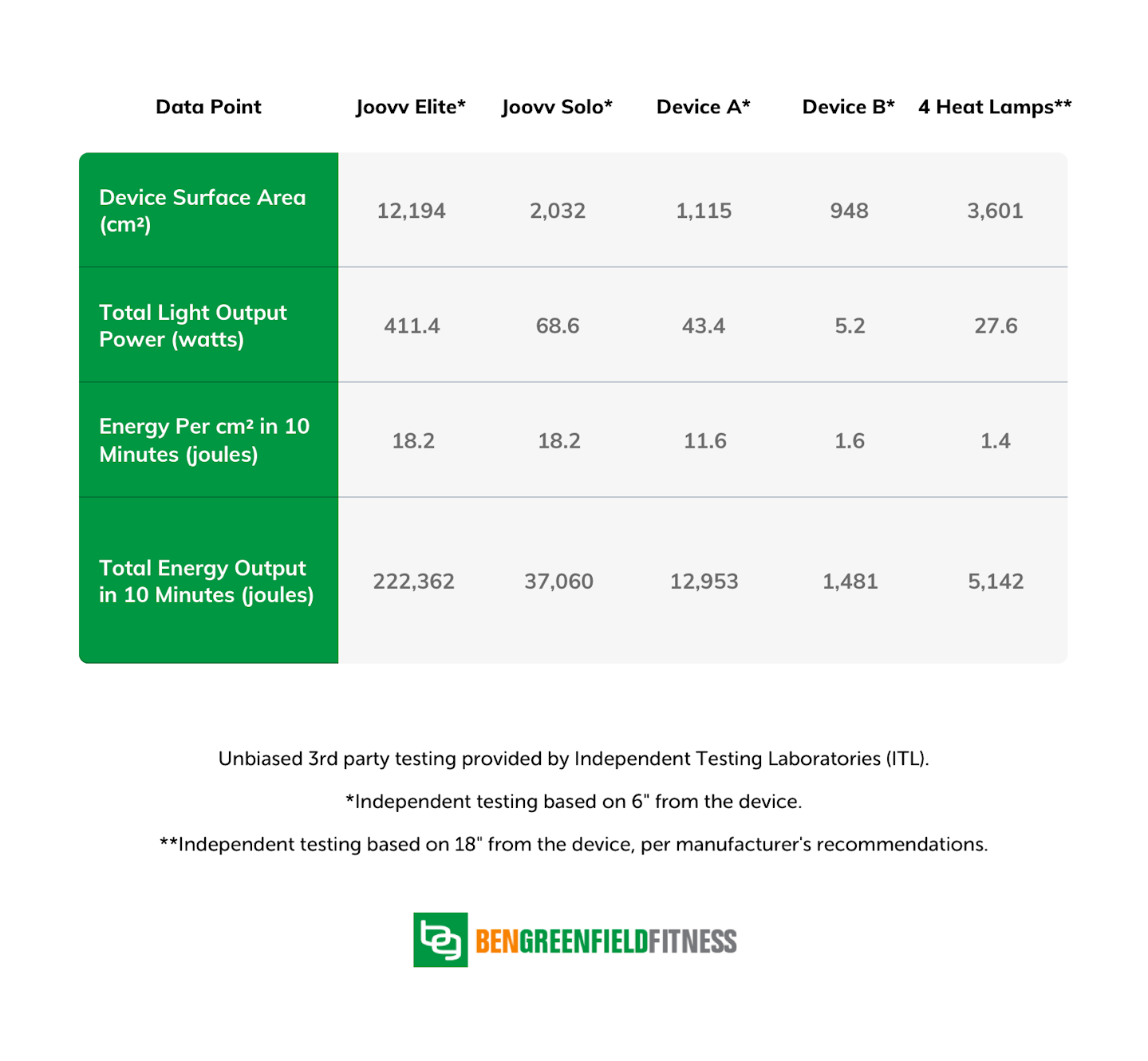 The numbers speak for themselves, but these are my key takeaways:
The numbers speak for themselves, but these are my key takeaways:
- Joovv delivers superior therapeutic power.
- Because of its size, the Joovv Elite is most effective.
- Beware of companies that make ridiculous marketing claims without the 3rd-party data to back them up. Sorry, devices A & B (heat lamps), you lose.
3. Treatment Area Size
As I mentioned above, it doesn’t make a lot of sense to think about a device’s power output without thinking about how much surface area the light covers on your body. You want to know what the device gives you, not what it can do in a vacuum.
Size matters a lot for light therapy devices because you get better results when you cover more of your body with an even distribution of light. Uniform coverage is key to optimal results, and a small device that only covers a fraction of your body simply can’t get the job done.
Targeted light therapy treatments can work well for specific areas like a scar, inflamed ankle, and yes, your balls. If you just want to shine a smaller device on your nether region every day, I’m certainly not going to stop you. Plus,you’re likely to see a rise in your testosterone and sex drive. But for the full range of benefits, you need to experience full-body treatment.
I’ll get to all the reasons why I prefer Joovv in a bit, but one of the biggest reasons is their modular design. Sort of like LEGO blocks, you can start with one of their smaller configurations—like the Joovv Solo—and then build out a full-body system over time. Or, if you’re like me and you want optimal results right away, you can choose something like the Joovv Elite right of the gate. I’m a good-sized guy, and that unit literally treats my entire eody from head-to-toe and side-to-side.
If you’re not convinced that full-body light therapy is the way to go, check out some of the graphs below (again, this 3rd-party data comes from ITL). As you can see, at about 12” from device A, the irradiance of 1 mW/cm2 is extremely low. Below that you’ll find a similar graph for a setup of 4, 250-watt infrared heat lamps. You need to be at least 18” away from those things (they get super hot!)—but at that distance—the irradiance again is only about 1 mW/cm2. With this type of power, you’re going to need hours to receive a meaningful dose of energy. Who has that much time every day? (Side note: I didn’t even include a graph for device B because it’s such a joke.)
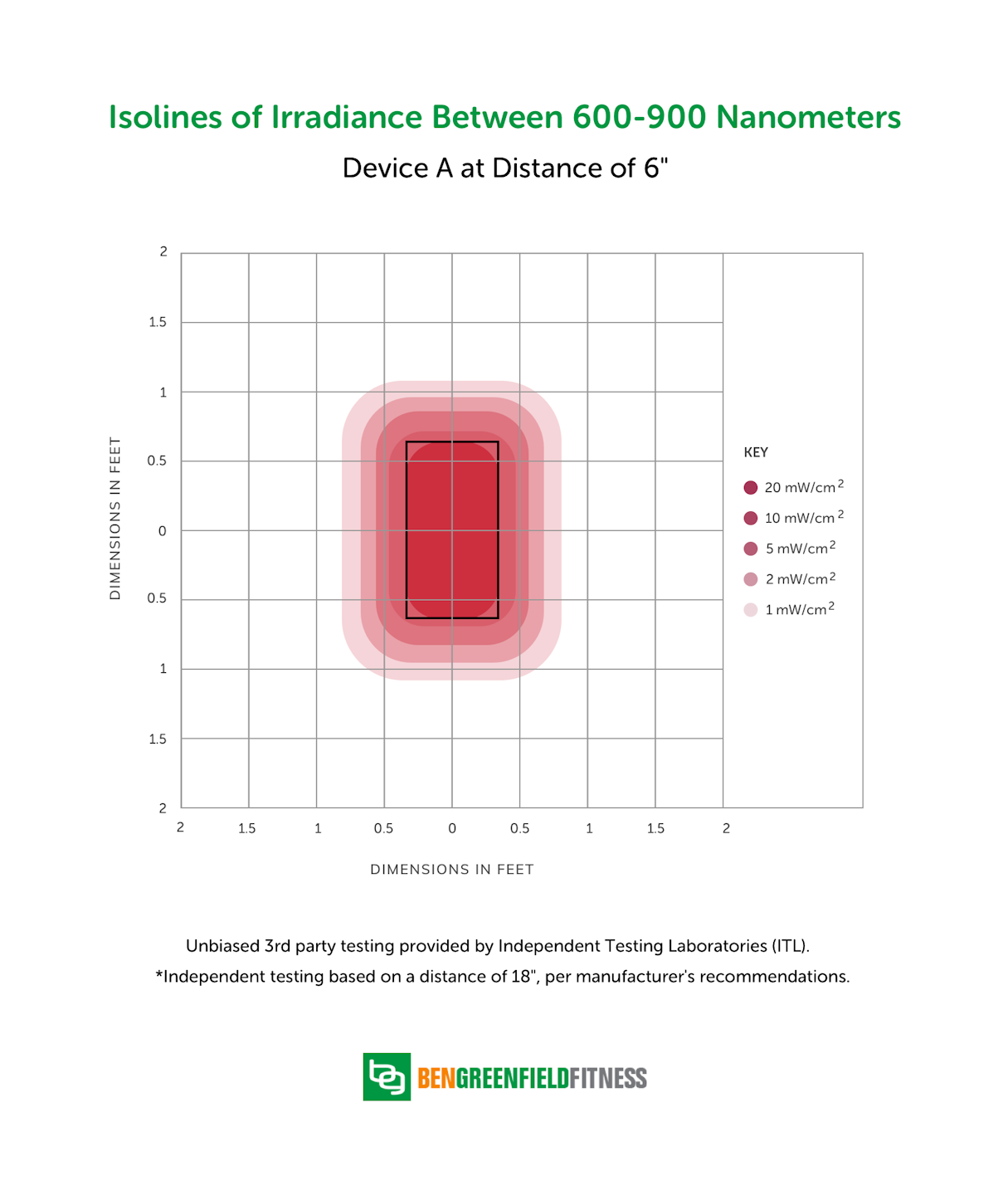

So here’s the deal: the total energy your body receives—which is the most important data point—is a direct function of three things:
- The quality of the source. Cheap LED devices and NIR heat lamps are extremely inefficient.
- The distance you are from the device. The farther you are, the less energy dose you’ll receive.
- The size of the device. If you’re after full-body light therapy (which you should be), you’ll need a full-body device.
4. Cleared by the FDA
You only get one body and one pair of balls, so safety first. Before buying a device, make sure the production process has been cleared by the Food and Drug Administration (FDA). This is an important distinction for photobiomodulation devices in particular because Class II FDA clearance requires a light therapy manufacturer to pass rigorous safety & quality tests for every component part that makes up a device. Maintaining a robust quality management system to monitor product performance is also part of the process too. The FDA go-ahead also makes it easier to use in clinical trials, where the medical science community further evaluates and tests the product.
Bottom line: if a light therapy device isn’t cleared by the FDA, I’d stay away.
Light Therapy FAQs
Because I’ve become one of the posterboys for light therapy, so to speak, as you can imagine I get a lot of questions (and hear a lot of misconceptions) about light therapy over and over. Here are some answers to some of the more common ones I hear on a weekly basis:
Is light therapy safe? Are there side effects? Can you do too much?
First, with an FDA-cleared device, it’s safe and comes with little to no side effects. And I’m not the only one that thinks this. A major 2013 study by Harvard and MIT researchers praised light therapy for its “noninvasive nature and almost complete absence of side effects.”
Regarding overuse, you can overdo just about anything that’s good for you, but it’s hard to get too much light therapy. I stick to 20-minute treatment sessions because the body of scientific literature says that particular energy dose is optimal and safe. But even if you did more, it’s hard to imagine a lot of negative effects. At a reasonable latitude, basking naked in the sun in all your glory, you’ll receive about 1 million joules of full spectrum light in about 1 hour. That’s a lot! By comparison, at a distance of about 6”, I get about 200,000 joules of red and NIR light standing in front of my Joovv for 10 minutes.
What do you do with a light therapy device and where do you use it?
You don’t have to do a whole lot. Just stand or sit in front of a high-quality device for 10-20 minutes a day (yes, you should be naked). I usually work or answer emails, but sometimes I get a little more meditative while the red and NIR light shines over my whole body.
You can do it anywhere you want. I Joovv in my office so I feel rejuvenated ahead of the work day. But there’s no wrong place to do it as long as you do it regularly. Some people hang their Joovv on a door, others mount it on a wall or use a mobile stand to get their red light wherever. A lot of people I talk to use it in their bathroom, or even in their workout area.
Is light therapy different from heat lamps?
Yes, and the answer is right in the name: heat. High-quality LED light therapy devices give off very little heat, and as I’ve written about before, heat can be bad news for your testicles and testosterone. Heat lamps simply don’t offer the clinically-proven wavelengths and total power output of a good LED light therapy device. For more specifics, check out the table and graph I included above.
Is LED flicker an issue?
Short answer: no, not with a high-quality LED light therapy device. But if you go with a bargain option, it might be.
Long answer: I’ve previously written that LED flicker can be a bad thing. But it largely comes down to these 3 factors:
- Cheap LEDs that you can pick up at the local Lowes or Home Depot may have a significant flicker rate, which can lead to eye strain, fatigue, and other uncool side effects. Stay away.
- The LEDs I mentioned above emit a lot of blue light. And if you know me, I’m not a fan of blue light after sunset. It disrupts your circadian rhythm, which impacts pretty much everything we do, especially sleep.
- If you get a cheap light therapy device without verified data and safety, all bets are off. But if you go with a high-quality light therapy product like a Joovv, you can trust that the flicker percentages are not just extremely low, but they’ve been tested by independent, 3rd-party sources.
What about EMFs?
There’s still a lot that we don’t know about EMFs and how they affect our health. But here’s my 5-second take, which I cover more in depth in the podcast “The Non-Tinfoil Guide to EMFs: How to Fix Our Stupid Use of Technology“. Basically, less than 100 years ago, our ancestors didn’t have to deal with things like EMFs. And with modern-day technology, you can’t reasonably expect that our biological systems can adapt that fast. So obviously, I try to minimize my exposure as much as possible.
So I did my homework on the Joovv and their design. Here’s what I found:
- Every LED driver inside a Joovv is encased in aluminum, which acts as a natural shield to EMFs.
- Power cords are notorious for emitting EMFs. Joovv actually custom-designed their power cords using 3 different manufacturing techniques to proactively minimize EMFs.
- As I mentioned before, their devices are cleared by the FDA. With that, you actually have to pass EMF testing. One more reason to go with a device that’s passed the FDA sniff test.
Summary
I’m always science-first, and the clinical research on light therapy is very convincing, for both effectiveness and safety. But ultimately I talk about light therapy so much because of what I’ve felt personally, and what I’ve seen in my friends and fitness colleagues. Since I started incorporating Joovv into my daily routine, I have more energy and testosterone, I recover from workouts faster, I sleep better, my skin is healthier, I feel positive and motivated after my treatments, and I can hit the work day running. Whether you’re looking for systemic benefits like weight management, sleep, testosterone and muscle building, or just trying to rehab from an injury or get a cosmetic skin boost, I highly recommend red and near-infrared light therapy, especially the full-body kind.
I can't recommend a Joovv more highly.
- Joovv is a science-first company that puts a huge amount of its resources towards education, service, and independent testing.
- Joovv is the only manufacturer with a modular design that lets you build a full-body system now—or over time. Coverage is key, and Joovv offers the industry’s biggest treatment area sizes at the most affordable prices.
- Joovv uses electrostatic-coated LEDs in their devices, which limits a lot of the energy loss you might see in shoddier PBM products. That means medical-grade power during shorter treatment times.
- Joovv gives me the option of switching between red and NIR light. Sometimes I like to be able to choose between the two if I’m after superficial or deep-tissue treatment.
- I trust Joovv’s manufacturing process. They’ve been cleared by the FDA, they minimize EMFs and flicker as much as possible, and I don’t feel any side effects from using it every day.
- The Joovv Go is a handy new travel device that’s just as powerful as the larger ones, but fits in the palm of your hand. It’s wireless and rechargeable too. I travel a ton, and this little guy is a game changer.
So if you're going to get a red light, you should, in my opinion, go with the Joovv. Here's how to get one:
Just go to BenGreenfieldFitness.com/Joovv If you enter code: BEN at checkout, you'll receive a free gift with purchase.
If you have more questions or comments, leave them below and I'll be happy to reply!


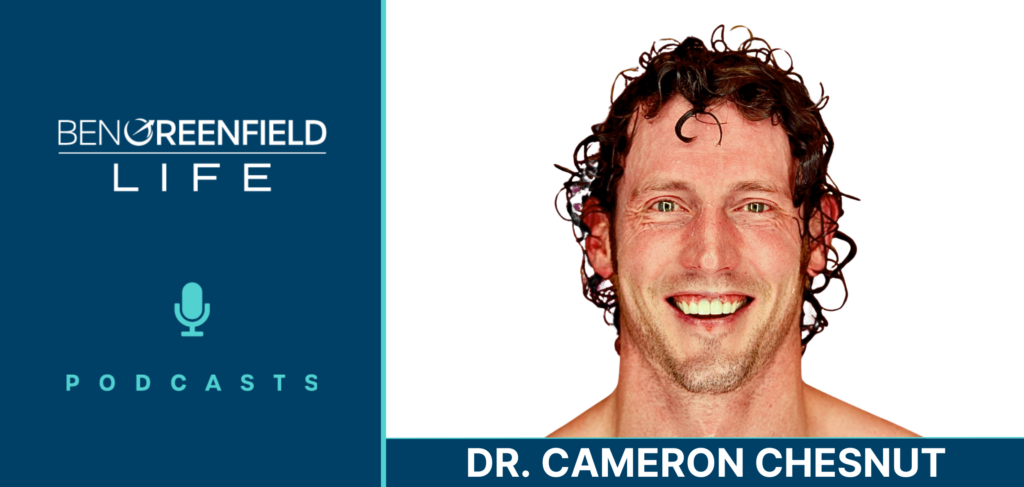

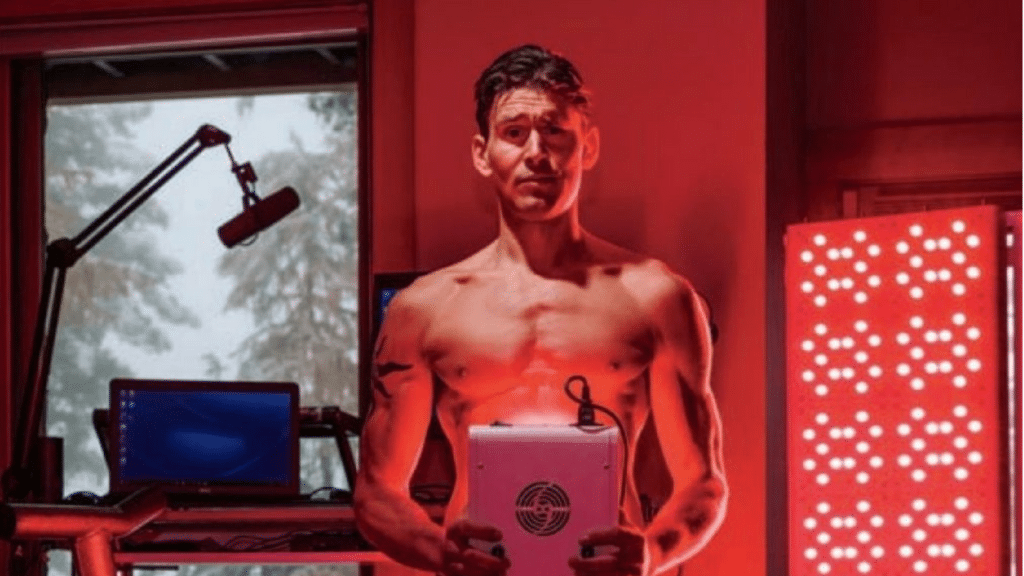
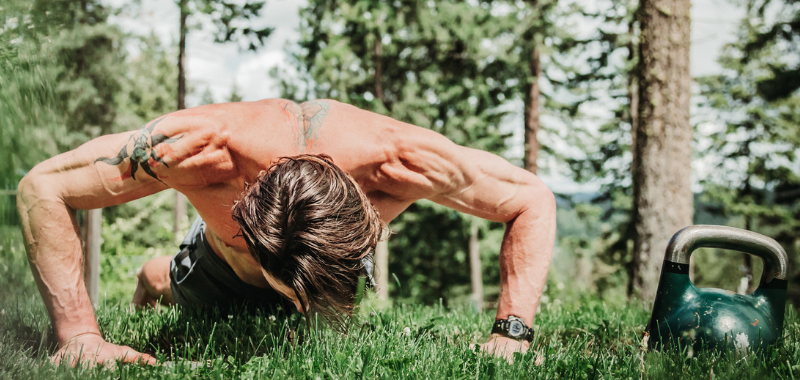



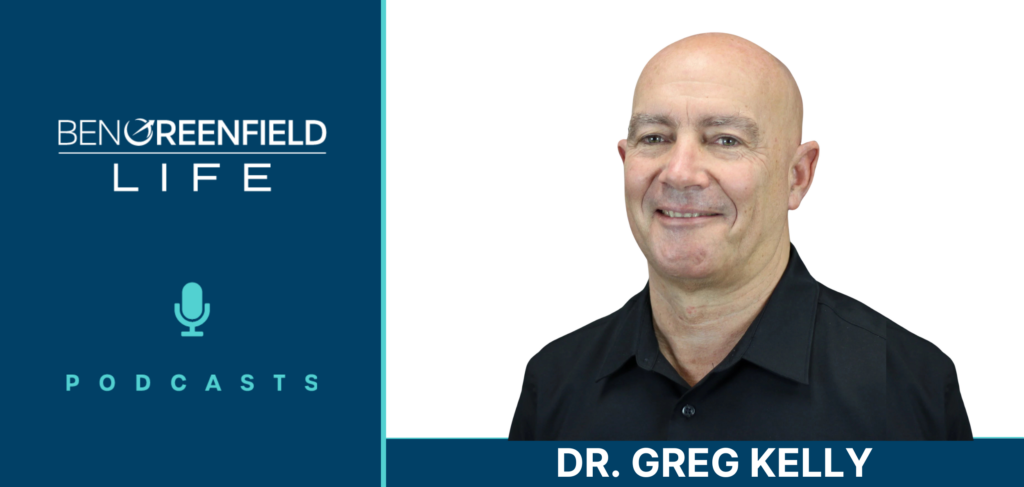




Does red light therapy have an affect on your body and also therapy room generate negative ions.
such useful information thanks for sharing it with us.
Everyone here should note that the FDA cleared, class II device status is not for the indication which is being promoted in this article. There are currently no cleared devices or product codes under FDA which are for a testosterone indication (and therefore, FDA reviewed clinical data for applying red light to your ‘balls’). The clearances are for anti-wrinkle, acne or hair regrowth indications. FDA registered devices indicate its for an LED light emitting indication (e.g. device intended for the body to promote healing, etc.). Those devices (registered) are not reviewed by the FDA, rather they are 510(k) exempt, and therefore, the manufacturer need only assemble their documentation and register the device on the FDA website upon paying the annual fee. Although they are still subject to GMP (good manufacturing practices), these companies will rarely be inspected by FDA.
Note: Joovv products are product code ILY under FDA, which means they are 510(k) exempt. This means they have registered their product, but none of their products are ‘cleared’ under a 510(k). Again, this means that FDA has not reviewed any nonclinical, preclinical or clinical data generated by Joovv on their products or claims. https://www.accessdata.fda.gov/scripts/cdrh/cfdoc…
Companies, like the one promoted in this article, should remember that *marketing* claims are considered labeling in the eyes of the Agency, and are therefore subject to their regulatory oversight. Meaning, companies should be wary of making or inferring claims about their product for which they are not indicated.
It turns out that there are so many benefits of red light therapy, which has benefited a lot, thank you
I want to know how long red light therapy is used for the best treatment effect! Who can tell me, thanks.
https://www.reddit.com/r/redlighttherapy/comments…
Great post!!
Thanks for sharing this post here with us.
What do you think of the clearlight version of red light therapy? It seems to be lower priced but has larger coverage due to the angle of the lights? Specs seem to show similar power and strength.
Some useful health tips people never can forget in their entire life because ‘health is wealth’. I do personally prefer skin diseases at Image Clinic. India’s best dermatologist available there. you may visit the clinic here https://imageclinicindia.com/best-skin-treatment-…
https://www.reddit.com/r/redlighttherapy/comments/pa3ma6/red_light_therapy_testosterone_results_with/?utm_medium=android_app&utm_source=share
Is this going to work in the long run? As I understand it, more testosterone will downregulate GnRH and LH and reduce your testosterone levels over time until you reach a new equilibrium, same as any testosterone booster.
Dear customer,
We are promotion for laser hair remover equipment, buy one get one free,you may take to think about it.
Great info and very insightful article Ben,
Fun act: During Medieval Times in England, a red dyed cloth was placed in the windows during sunny days, patients would lay in the red sunlight whole day to treat there diseases 🌞
Can I ask what is the best time to joovv morning or evening. If you joov in the evening does it effect sleep.
Ben noticeably quiet when Joovv competitors are mentioned…I think I smell more than a whiff of conflict of interest here..
Your senses are correct. The Joovv guys are bullies of the highest order. They’ve attempted to destroy what they think is their competition via fraudulent claims and extortion. Worst kind of humans. Aside from this their products are massively overpriced and massively over-hyped. Check out their latest attempt at bullying a small company:
https://gembared.com/blogs/musings/our-response-to-joovvs-patent-threats?fbclid=IwAR38tz2Xagr7xkh2o2IrCNDQ5mvKEKv-GVY3IL1puWYr_p-CVLQkKoCmkvk
Trustpilot.com has lots of negative reviews for the Joovv.
Try Platinum LED Biomax series. Incredible.
https://platinumtherapylights.com/products/biomax-rlt
Hi there, I would love to start light therapy at home and understand that not all lights are the same. I am a Big Ben and Bulletproof fan who both recommend Joovv but I can’t justify the $2-3k at the moment. I was looking around and found this one that “appears” to have the same specs and is conveniently on sale at the moment. https://www.redalternative.ca/products/half-body-…
Does anyone know if this brand stands up to the 3rd party testing and quality Ben talks about in here? Thanks so much!
Ben:
What are your thoughts on the new Red Light Therapy option for Clear Light Saunas?
I haven't used it because I have a Joovv but clearlight is a company I use and trust.
Does red light therapy have an affect on your central nervous system?
I thought you said these were now affordable? At least not this brand. I think for the time being I will just step out in to the sun.
Hey Ben, Have you heard anything or know of any test that show red light therapy helping women with their hormones or increasing their libido? I’ve been using the Joovv Duo everyday for under a month, I’m currently mid-cycle and uh hello to increased libido! This is coming from a woman who is lucky if she got the urge at least twice a year. I can’t find anything talking about how it can help women’s hormones.
Hi Ben, i wanted to post a reply to this post. People read your blog, I read your blog, and give attention to what you say. It takes a while to build credibility with your audience. Based on your recommendation, i purchased a Joovv product, and unfortunately the whole experience turned into a nightmare/ disaster. Now the only feeling i remember when thinking Joovv is how ripped off i was, why on earth would you help these people their business, blows my mind
Misty,
Can you please explain some of the downfalls you experienced?
Thanks
When using red light therapy for endurance athletes would you still use beet root or another nitric oxide booster? It seems with the mechanism by which red lights helps to produce more ATP you wouldn’t want to flood the body with nitric oxide. But we know additional nitric oxide can help with endurance by expanding blood vessels. Thoughts?
Hey Ben my testicles move around when I expose them to the red and nir lights, and some times I get sensations in them throughout the day afterwards. Is this normal? I have read reports of guys experiencing this when subathing their testicles.
I've heard of anecdotal reports similar to this. It's hard to offer definitive guidance, but it's likely just your individual physiological response to red and NIR wavelength of light. Although NIR light isn't dangerous, you could try using only red light alone to see if that results in any differences. Hope that helps!
https://www.reddit.com/r/redlighttherapy/comments/pa3ma6/red_light_therapy_testosterone_results_with/?utm_medium=android_app&utm_source=share
Testicles shift up and down constantly because they react to temperature. The slight in the lamp will lower them to cool off and a breeze or cold sensation will raise them
Ben – Jack Kruse has been steering people away from the Joovv based on it having a high flicker rate. What is your thoughts?
Also is the flicker rate lower on the Joovv Go based on it operating off of batteries?
Thanks.
I’m curious about that independent 3rd party verified table you have for the 5 devices. I’ve read everywhere that you want at least 100 mW/cm2 of irradiance (I know talked about how total power is what matters, but thats if youre doing full body. I’m using it for nerve damage in my fingers, in which case irradiance matters…i want the proper amount of power output on those tiny cm2 as possible). My question is I cant make the math work on your table.
If the Joov Elite has 18.2 joules/cm^2 in 10 minutes, and 1 watt = 1 joule/sec, then 18.2 joules for 10 minutes = 18.2/10/60 = .03 watts/cm^2, or 30 milliwatts/cm^2, which is very low (below the 100 mw/cm2)?
It is good to do the math, which you have done. So, in front of the LEDs, there are lens, to help throw the light forward. These optics can often concentrate the intensity of the forward light between 2.5X – 3X, which will make the irradiance measurements read that much higher; ie. approx. 100 mW/cm^2. But, they do not help to increase the total light power (total joules) from the LED source. Hence, often other companies also depend on optics for their higher than calculated irradiance claims.
What kind of red light can I use next to my computer to mitigate blue light damage to my eyes? Is there a small bulb or string of LED lights that can be used for this purpose?
I like red incandescent bulbs. You can get them from Amazon. I'd also look into Iris for your computer, or even some blue blockers. I like RA Optics: https://raoptics.io/ref/25/ (Code: BEN10)
From Australia here, the JOOVV stuff looks great but It will be really expensive with exchange rates, I found this Aussie company what do you think? https://www.redlighttherapy.com.au/about/
try red light rising
It would have been informative to know who Device A and Device B were made by. I bought a PlatinumLED Light Therapy BIO600 because they use 3 watt LED’s rather than the 2 watt LED’s used by JOOVV. It would also have been nice to have been informed at the beginning of this article that it was just a commercial for JOOVV and used all the JOOVV data that is on their website. This IS NOT a BIAS-FREE article about Red Light therapy. It is a disguised commercial for which you receive a kickback from JOOVV. More FAKE NEWS from the media.
I feel like PlatinumLED may be too strong? can you provide the comparisons at equal distances?
No such thing as too strong, because you can vary the distance to the target and get the proper amount of exposure. Most quality lights with come with distance and time recommendations. The nice thing about the more powerful lights is you can get greater target to light distance and still have therapeutic results.
For example, you have many cheap lights that will work on the skin, but it has to be right against the skin. You get a more powerful light like the red rush 360 or platinum where you get max skin benefits at 36 inches! This allows pretty much full body expose from even the smaller units.
If I can only go with one Go device, and my main interests are shining on my testicles, and also off-setting minimal sun exposure with light therapy, should I go with Red or NIR?
Both Red (660nm) and NIR (850nm) wavelengths have been proven to be beneficial for a wide range of the same desired treatments, such as testosterone, skin health, etc. When choosing which Go unit you'd prefer, the Red is better for skin treatment at the surface, where the NIR is best for deep tissue treatment. So both are beneficial, it's just a matter of picking which works best for you.
It seems NIR would offer general as well as deep, targeted benefits? Will you personally travel with both, or alternate depending on your needs?
Joovvs are pricey – can also check out a company called Mito Red Light for a more affordable option.
Also check out a manufacturer called PlatinumLED Light Therapy. They use 3 watt LED’s compared to the 2 watt LED’s used by JOOVV. Plus, they are about 40% cheaper than the JOOVV units.
I agree that Joovv is very overpriced. PlatinumLED and Red Therapy make high quality boxes that are more powerful than Joovv at half the price.
PlatinumLED is a very well regarded maker of better grow lights. Look at their thousands of reviews on amazon. A therapy light is made by simply installing LEDs at the right frequency. Both PlatinumLED and Red Light Therapy claim to be low EMF.
(I am in no way connected with any of these companies. I just find the Joovv pricing ridiculous).
Plus you can turn off infrared when doing skin treatments
I have done tons of research and this Mitro is my pick. Plus their lights are 5 watts each
So even using a small unit with less lights per square in it is more powerful and they post independent
Testing. Not sure what Ben is aging because I didn’t see any studies or light
Wattage per each bulb.
Just saying,
Don’t be fooled by whether a ‘3W’ LED or a ‘5W’ LED is being used. The total ‘consumed power’ will reveal whether or not the LEDs are being run to their maximum power ratings. (Often they are not) So, a ‘5W’ LED may perform with less output power if it is only run at 1/3 of its power rating, and if a 3W LED is compared to it, running near its max power rating, more light will be delivered from it than the ‘5W’ LED. Adequate heat management is also a major component in LED performance. Also, a fully maximized 3W LED can deliver about 20% – 25% light power from the total electrical power put into it. So, a fully running ‘3W’ LED could deliver 600 mW – 750 mW of light energy, A partial running 5W LED may also be limited to the same light output too.
Do you know this Paneels? MITOPRO I just compared them to the PlatinumLED BIOMAX – https://mitoredlight.com/products/mitopro-series https://platinumtherapylights.com/products/biomax-rlt?variant=15666982649922 they seem very similar, except for 3W / 5W Led
When you use the joovv to boost t-levels do you use both red and NIR or do you just use the red setting? I’ve been using my joovv for about a month and I only use the red on my testes because I would think that NIR might be bad for them.
I use both
How often do you have to use it and for how long?
I usually Joovv daily for about 20-30 min per day.
Hi Ben, I recently re-listened to your 32 natural ways to naturally boost testosterone podcast and you said that when using red light for increasing testosterone you don’t want to exceed about 820 nanometers or so because then you get this heating effect that can damage sperm that can lower testosterone production. The Joove has NIR at 850 nanometers so I am just wondering for men wanting to focus on testosterone increases should we stick to the infrared setting at 660. Appreciate your input and thanks for all the great information.
Have you looked at the truelight from truedark.com? https://truedark.com/truelight/
Any idea if you can use your health savings account (HSA) on a joov? I have seen other light therapy products that these funds can be used for. Thanks!
It would be best to consult your insurance provider on a question of this nature.
You mention “The Joovv Go” – “a handy new travel device that’s just as powerful as the larger ones, but fits in the palm of your hand. It’s wireless and rechargeable too. I travel a ton, and this little guy is a game changer.”
I can’t find this product on Joovv’s website?
Hey George,
You can see details on the new Joovv Go here- https://joovv.com/pages/joovv-go
Let us know if you have any other questions by going to help (at) joovv dot com.
Hey Ben,
I love the article.I was wondering.I use a full spectrum Infrared sauna along with the intranasal Vielight product,which I truly love and feel.Is this giving me adequate red light exposure or would you recommend additional reinforcements?And if so,what would you recommend?
Interesting stuff. Anyone looking to grow taller check out heightify.com. I just grew 2 inches at 32, it uses subliminal programming. Keep up the great content brother.
Are there recommendations for the best time of day if you want to increase testosterone? Same question as far as improving sleep. I’ve seen some people saying that red light at night is good to counteract all of the blue light we get from our screens, but it also seems like red light would be “energizing” and perhaps not the best thing to do right before bed. Thoughts?
Hey Jeremy, it’s the the Joovv team here. In our opinion, the most optimal time is within 1 hour of sunrise or sunset. This is when the red and near-infrared wavelengths are strongest in full spectrum sunlight. Again these are the most optimal times, but it’s beneficial (and SAFE) to use your Joovv anytime during the day because these particular wavelengths are always present in natural sunlight.
In regards to sleep, check out this recent article we posted on our blog page- https://joovv.com/blogs/joovv-blog/how-red-light-helps-you-sleep-better
If you have any additional questions, feel free to reach out to our customer support team at help (at) joovv dot com.
I typically use the Joovv in the morning.. But I also use red lighting in my office if I'm working at night. The absence of the blue light will keep your body regulated to a more natural circadian rhythm.
For instance, if I were to buy a Jovv mini, how close do you recommend to your testicles for the desired effect?
Hi there!
For optimal results, we recommend positioning your Joovv approximately 6 inches from the area on your body that you intend to treat. The recommended default treatment time is 10 minutes per treatment area, which will result in an effective dose, that is clinically proven.
Is there a known ratio of distance to time? In other words, if you double the distance to 12 inches, how long would it take to receive the same dose of light?
And specifically for T, would it be best to use red, NIR, or both?
Thanks.
I see that question has already been answered, (both wavelengths).
I can’t seem to find this one though:
What is the optimum treatment area to increase melatonin?
And can I assume all other parameters to be the same (both wavelengths, 6″ distance, 10min dose)?
Thank you.
Recommended treatment, according to Joovv, is 10 minutes at roughly 6 in away from device.
I’m a much bigger fan of the REDjuvenator (#3) by Leanne Venier which has multiple types of red light and near infrared combined with catalyzing quantum energy healing codes.
This is my favorite device too.
Hey Ben,
I was wondering do one side of your body for 20 minutes or switch it up, 10 minutes each side? Also I have the Joovv mixed near and far. When I look at the lights the red ones turn green for me. I emailed the company to see if that is thing with some people but did not get a reply. Have you ever seen this?
Thanks,
Hey Kathleen, it’s the Joovv team here. Our recommended treatment time is 10 minutes per area, which will result in a clinically-effective dose of energy.
It’s important to be consistent with your light therapy treatments. That’s why we recommend using your Joovv every day, or at least 5 times per week. For additional health benefits, including pain relief from aches and strains, up to 3 treatments per day can be helpful.
Lastly, in regards to the color changing, what you are experiencing is the rods and cones in your eyes adjusting to the bright light. Not all of these cones are alike. About 64 percent of them respond most strongly to red light, while about a third are set off the most by green light. Another 2 percent respond strongest to blue light. When these photoreceptors are exposed to red light, the resulting signal is zapped along the optic nerve to the visual cortex of the brain, which processes the information and returns with a color: red. When our eyes are exposed to bright red light, the cones and rods try to adjust. The result is that you can see a green, yellow or blue tint for a minute or two and it isn’t something to be alarmed with. If you have any additional questions, feel free to reach out to our customer support team at help (at) joovv.com.
General recommended treatment is 10 minutes, approximately 6 in away. Adjust accordingly dependent on how big an area you are treating.
Hi Ben
I purchased the Joovv Solo And I have noticed many of the benefits mentioned in this article. I always use it on the dual mode with both red light and near infrared light mode. When would I use only one mode versus both modes? Wouldn’t both modes always be better?
Hey Sean,
It’s the team from Joovv. Great to hear that you’ve been experiencing some nice benefits! For optimal health, we recommend using both red and near infrared light at the same time. The only instance where we’d recommend not using both is if you happen to be photosensitive to a certain wavelength or if there are other health-related issues that are exacerbated by photobiomodulation (very rare). If you have any additional questions, feel free to reach out to our customer support team at help (at) joovv dot com.
hi Ben
you have and use both the clearlight sauna and the joovv lights… is this not redundant ?
on your recommendation I bought a clearlight sanctuary,,, what benefits would I get using the joovv lights that I am not already getting from the sauna ?
I appreciate your time to answer
The sauna is far-infrared which primarily concerns heat, detoxification, and sweating. This article is about red and near-infrared light spectrum which stimulated collagen production, testosterone, wound healing, etc. Some of the benefits overlap for example your sauna will stimulate wound healing and help combat depression but they differ in crucial ways too for example your sauna won’t stimulate hair follicle growth, mitochondrial biogenesis, and may actually be detrimental to testosterone since you’re overheating your… um… guys. The “guys” don’t so much like to be heated.
Anyway that’s what I’ve gathered. I’m not a doctor nor do I play one on the internet.
Check out RedRush- it’s a reasonable alternative to joov
Hi Ben, I’m a long time follower of your podcast! I found this article https://saunaspace.com/saunaspace-vs-joovv/ about sauna space vs joovv. I want to get your take on their claim that Joovv is not telling the full story accurately.
Another long tome follower here with the same question.
+1 Yep, I would like to hear Ben’s opinion on this one as well
According to the article it seems both companies claim the other company’s product may cause you more harm than good.
This selling practice is unfortunate because my take-away is I am not sure if either product will help me or harm me, the only thing for sure is I will be spending a lot of time and money so the obvious choice is to buy neither. I wonder if competing companies realise that is the affect they have when condemning each other’s products.
From what I can gather, if you are at a decent latitude you are better off sunbathing naked for let’s say 20 minutes, about the same amount of time to get your vitamin D
What latitude would that be? And is the time of year important like it is for UVB and therefore vitamin D?